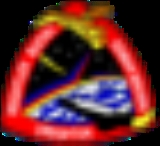
STS-44
Encyclopedia
Mission parameters
-
- Launch: 117766 kilograms (259,629.6 lb)
- Orbiter landing with payload: 87919 kilograms (193,828.2 lb)
- Payload: 20240 kilograms (44,621.6 lb)
- PerigeePerigeePerigee is the point at which an object makes its closest approach to the Earth.. Often the term is used in a broader sense to define the point in an orbit where the orbiting body is closest to the body it orbits. The opposite is the apogee, the farthest or highest point.The Greek prefix "peri"...
: 363 kilometres (225.6 mi) - Apogee: 371 kilometres (230.5 mi)
- InclinationInclinationInclination in general is the angle between a reference plane and another plane or axis of direction.-Orbits:The inclination is one of the six orbital parameters describing the shape and orientation of a celestial orbit...
: 28.5° - PeriodOrbital periodThe orbital period is the time taken for a given object to make one complete orbit about another object.When mentioned without further qualification in astronomy this refers to the sidereal period of an astronomical object, which is calculated with respect to the stars.There are several kinds of...
: 91.9 minutes
Mission highlights
The launch was on 24 November 1991 at 6:44:00 pm EST. A launch set for 19 November was delayed due to replacing and testing a malfunctioning redundant inertial measurement unit on the Inertial Upper StageInertial Upper Stage
The Inertial Upper Stage , originally known as the Interim Upper Stage, is a two-stage solid-fueled booster rocket developed by the U.S...
booster attached to the Defense Support Program satellite. The launch was reset for 24 November and was delayed 13 minutes to allow an orbiting spacecraft to pass and to allow external tank liquid oxygen replenishment after minor repairs to a valve in the liquid oxygen replenishment system in the mobile launcher platform. Launch weight was 117766 kilograms (259,629.6 lb).

Defense Support Program
The Defense Support Program is a program of the U.S. Air Force that operates the reconnaissance satellites which form the principal component of the Satellite Early Warning System currently used by the United States....
(DSP) satellite and attached Inertial Upper Stage (IUS), deployed on flight day one. Cargo bay and middeck payloads included the Interim Operational Contamination Monitor (IOCM), Terra Scout, Military Man in Space (M88-1), Air Force Maui Optical System (AMOS), Cosmic Radiation Effects and Activation Monitor (CREAM), Shuttle Activation Monitor (SAM), Radiation Monitoring Equipment III (RME III), Visual Function Tester-1 (VFT-1), Ultraviolet Plume Instrument (UVPI), Bioreactor Flow, Particle Trajectory experiment, and Extended Duration Orbiter Medical Project, a series of investigations in support of Extended Duration Orbiter.
The landing was on 1 December 1991 at 2:34:44 pm PST, Runway 5, Edwards Air Force Base
Edwards Air Force Base
Edwards Air Force Base is a United States Air Force base located on the border of Kern County, Los Angeles County, and San Bernardino County, California, in the Antelope Valley. It is southwest of the central business district of North Edwards, California and due east of Rosamond.It is named in...
, California. The rollout distance was 11191 feet (3,411 m), and the rollout time was 107 seconds. The landing weight was 193825 pounds (87,917.5 kg). The landing was originally scheduled for Kennedy Space Center
Kennedy Space Center
The John F. Kennedy Space Center is the NASA installation that has been the launch site for every United States human space flight since 1968. Although such flights are currently on hiatus, KSC continues to manage and operate unmanned rocket launch facilities for America's civilian space program...
on 4 December, but the ten-days mission was shortened and the landing rescheduled following the 30 November on-orbit failure of one of three orbiter inertial measurement units. The lengthy rollout was due to minimal braking for test. Atlantis returned to Kennedy on 8 December.
See also
- Space scienceSpace scienceThe term space science may mean:* The study of issues specifically related to space travel and space exploration, including space medicine.* Science performed in outer space ....
- List of space shuttle missions
- List of human spaceflights chronologically

